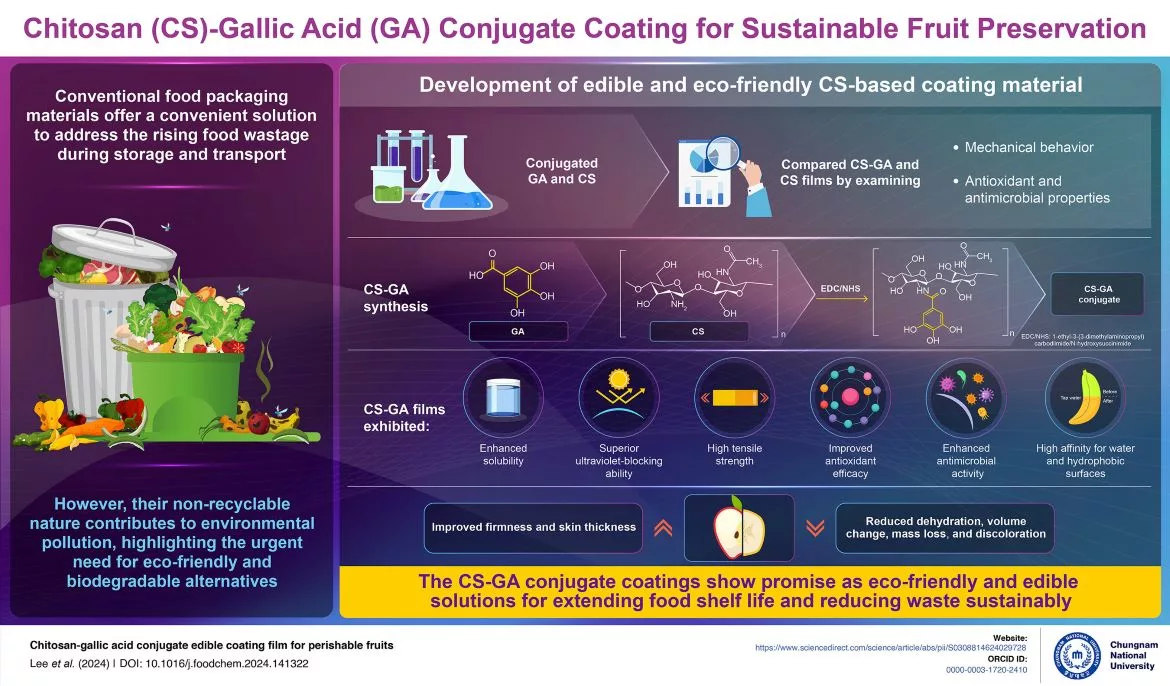Chungnam National University Researchers Develop Edible Biofilm to Extend Fruit Shelf Life

Image courtesy of Chungnam National University.
With advancements in transportation technology, access to fresh food has significantly improved. However, this progress has also raised concerns about food waste during transport and storage. Globally, about 17% of food at the retail and consumer levels is wasted, contributing to environmental issues such as groundwater contamination, hazardous gas emissions, and the spread of infectious pathogens. To address these challenges, researchers are exploring cost-effective, eco-friendly food preservation technologies. Among these, edible coatings made from naturally occurring polymers show promise.
A research team from Chungnam National University in South Korea has developed an edible biofilm using a chitosan and gallic acid conjugate as an eco-friendly, non-toxic food coating material. This biofilm helps extend the shelf life of perishable fruits by preventing water loss and gas exchange, reducing reliance on refrigeration and synthetic preservatives.
Chitin, a natural polymer derived from the crustacean exoskeleton, can be chemically modified to produce chitosan (CS), a biodegradable, non-toxic material with film-forming properties. However, CS has limitations, including weak barrier and antimicrobial properties. To enhance its effectiveness, the research team, led by Professor Won Ho Park, incorporated gallic acid (GA), a polyphenolic compound known for its strong antimicrobial and antioxidant properties, to create a CS-GA conjugate.
"We wanted to develop a CS-based biofilm with enhanced food coating properties, and we were hopeful that incorporating GA would help achieve that," said Park. Their findings, published online on Sept. 16, 2024, will appear in Volume 463, Issue 2 of Food Chemistry on Jan. 15, 2025. The study details the synthesis and characterization of the CS-GA film, comparing its performance to CS-only films and testing its efficacy on stored mini bananas and cherry tomatoes.
The research demonstrated that the CS-GA film exhibited improved mechanical strength, protecting food from damage during transportation. It also enhanced antioxidant properties, extended shelf life, and provided antibacterial activity against multiple microbial species. Additionally, the biofilm offered superior UV-blocking capabilities, reducing photo-discoloration and damage.
"Many consumers are concerned about remaining coating residues on fruits," said Park. "The washability of this conjugate makes it appealing. We also observed a significant reduction in dehydration, discoloration, and mass loss in stored fruits, indicating improved freshness and extended shelf life."
This green technology could play a crucial role in reducing food waste and supporting the United Nations' Sustainable Development Goal of halving food waste by 2030. "Previously, addressing food waste primarily involved collecting and disposing of scraps," said Park. "Our research suggests that enhancing food preservation capabilities through eco-friendly approaches could significantly reduce waste during distribution."
Reference
Title of original paper: Chitosan-Gallic Acid Conjugate Edible Coating Film for Perishable FruitsJournal: Food ChemistryDOI: 10.1016/j.foodchem.2024.141322
Learn more about the institution at Chungnam National University.
Looking for a reprint of this article?
From high-res PDFs to custom plaques, order your copy today!






